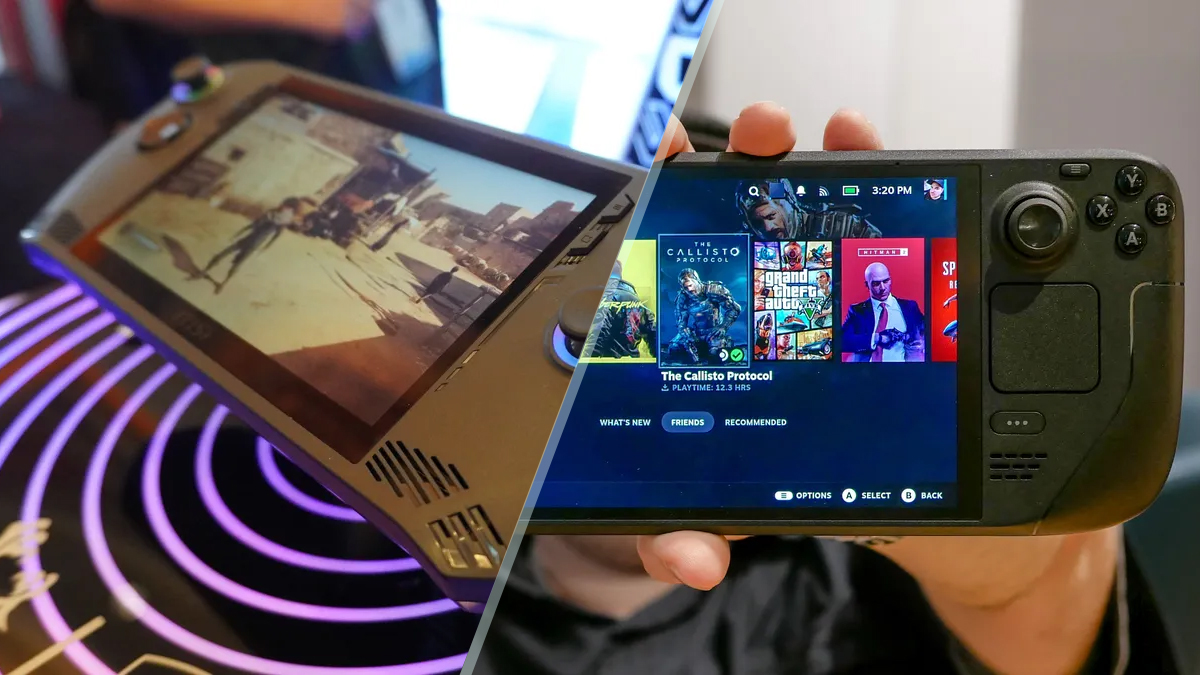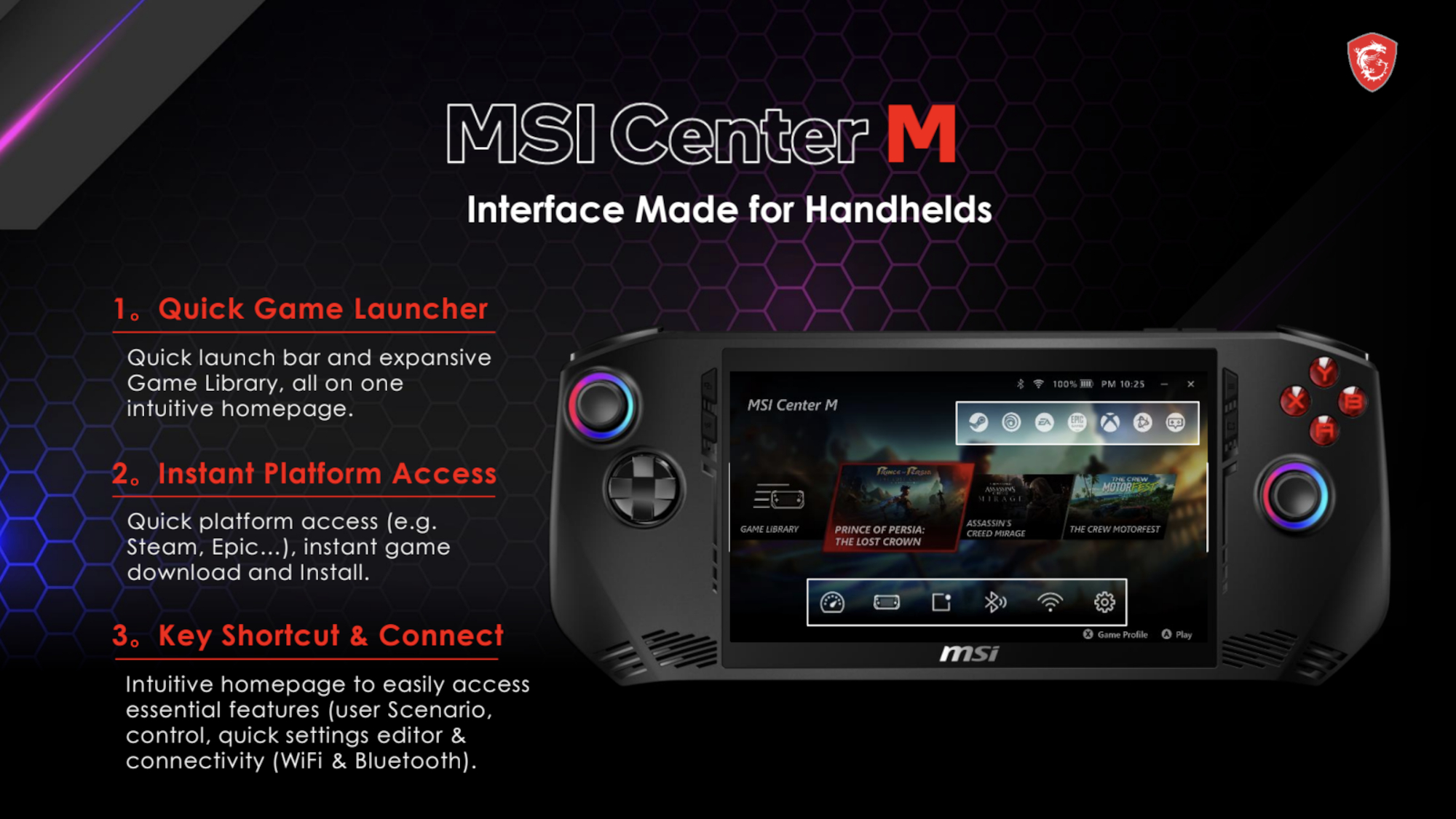I own a Steam Deck OLED and the MSI Claw has me worried — here's why
Come at the king and you best not miss? MSI looks to have the Deck in its sights

Since its launch in 2022, the Steam Deck's crown has been tested more times than various nefarious schemers tried to pinch the Iron Throne in a certain HBO mega hit. The Asus ROG Ally, Ayaneo Air 1S and Lenovo Legion Go have all come for the king and only ever so slightly missed. For my money, the OG Steam Deck is still the best portable PC you can buy in 2024.
Actually, that’s clearly nonsense. Obviously the Steam Deck OLED is the best handheld PC of the moment. Yet even Valve’s wonderfully updated device and its sensational screen could be tested (and possibly dethroned) by a new pocket-sized PC that currently looks like the real deal.
Enter the MSI Claw. Badass name, right? My colleague Tony Polanco has already done a hands-on review of the latest Steam Deck rival, and as he says in his piece, this baby could make Valve’s machine seriously sweat.
Specs-wise, the MSI Claw has a whole lot going for it"
Specs-wise, the MSI Claw has a whole lot going for it. While we’ve seen 1080p screens in the portable PC space before, the biggest weapon in its arsenal is its processor.
The Claw is the first gaming handheld to use an Intel Core Ultra CPU, and this new Meteor Lake chip uses the same Intel Xess tech you’ll find in the firm’s Arc GPUs.
Why is this such a big deal? Because this tech works a bit like Nvidia DLSS and AMD FSR. Namely, it renders games at lower resolutions, then uses machine learning to upscale the image to the Claw’s native 1080p resolution. The results? Higher frame rates with only minor compromises to image quality. If/when Valve gets around to making Steam Deck 2, I really hope the device is treated to a form of tech like DLSS.
As much as I love my Deck OLED, we’re still talking about a machine that can struggle to run many modern games at a locked 30fps, even with medium to low graphics settings enabled. Right now, that’s why the MSI Claw and its Meteor Lake processor make it look like a potential Deck destroyer.
Interface the music

It’s not just on the CPU front the Claw has a clear advantage over the Steam Deck and Steam Deck OLED. The other big weapon it has up its sleeve is MSI Center M: A custom interface specifically built for MSI Claw that looks like it could rival and even outgun SteamOS.
One of the main reasons the Deck has managed to remain more popular than its more powerful rivals is because its operating system is such a joy to use. Yet with the impending arrival of MSI Center M, it now finally looks like it has a worthy rival that’s in a different league to the likes of the cumbersome Windows 11 interface of the Asus ROG Ally.
The main draws of MSI Center M are its Quick Game Launcher and the fact you can easily tinker with performance and power-saving features, while also being able to tweak the handheld’s RGB lighting — another cool (if somewhat clichéd) feature Steam Deck lacks.
"The Claw’s interface allows you to access Xbox Game Pass and the Epic Games Store easily"
Even more impressively, the Claw’s interface allows you to access Xbox Game Pass and the Epic Games Store, neither of which are available on the Deck without some serious tweaking. What’s more (and perhaps this may prove to be the killer blow), the Claw also lets you quickly launch your Steam library.
For the moment, Valve still has a comfortable market lead in the handheld gaming space, and rightly so. While the original remains a great gaming device, Steam Deck OLED takes all the winning accessibility of the OG model then massively boosts its appeal with the best screen we’ve ever seen in a handheld.
Yet it’s clear Gabe and company absolutely should not be resting on their laurels. Not only is the MSI Claw coming for the firm’s breakout device, but the upcoming Ayaneo Next Lite (which boasts its own “Steam OS clone”, thanks IGN) may yet prove to be an equally serious contender.
For now, the Steam Deck and its updated OLED model still hold a comfortable lead. Yet as we’ve seen with the seesawing success between Sony and Microsoft in past console wars, it’s rare a platform holder can knock back every competitor that comes for its shiny crown.
More from Tom's Guide
Sign up to get the BEST of Tom's Guide direct to your inbox.
Get instant access to breaking news, the hottest reviews, great deals and helpful tips.

Dave is a computing editor at Tom’s Guide and covers everything from cutting edge laptops to ultrawide monitors. When he’s not worrying about dead pixels, Dave enjoys regularly rebuilding his PC for absolutely no reason at all. In a previous life, he worked as a video game journalist for 15 years, with bylines across GamesRadar+, PC Gamer and TechRadar. Despite owning a graphics card that costs roughly the same as your average used car, he still enjoys gaming on the go and is regularly glued to his Switch. Away from tech, most of Dave’s time is taken up by walking his husky, buying new TVs at an embarrassing rate and obsessing over his beloved Arsenal.
-
droideka75 This is a fluff piece. How this should read: I only ever owned a steam deck and have no idea how the Ally works (it's the same)Reply -
thebeardedparrott Reply
Exactly. I created an account just to comment and say the same thing. The only reason why the steam deck has more market share, is its earlier arrival and the fact that it's on steam for purchase, so I guaranteed a lot of people just aren't aware of the other options.droideka75 said:This is a fluff piece. How this should read: I only ever owned a steam deck and have no idea how the Ally works (it's the same)
The ROG Ally and Legion Go beat the Deck in every regard minus the OLED version's screen and that's minor. You're getting more power, more features, and a full Windows 11 operating system with the other devices.
You could probably put SteamOS on those other devices if you really wanted to. -
drrasii Reply
Agree with both posts above. Author seems to be an SD fanboy or is uninformed. The claw is basically an Ally clone and doesn’t do anything new or different except for using Intel.thebeardedparrott said:Exactly. I created an account just to comment and say the same thing. The only reason why the steam deck has more market share, is its earlier arrival and the fact that it's on steam for purchase, so I guaranteed a lot of people just aren't aware of the other options.
The ROG Ally and Legion Go beat the Deck in every regard minus the OLED version's screen and that's minor. You're getting more power, more features, and a full Windows 11 operating system with the other devices.
You could probably put SteamOS on those other devices if you really wanted to. -
leledumbo Having seen how Meteor Lake could win against AMD's counterpart, you won't have to worry. It still is a power sucker. Yes it can beat Z1 Extreme let alone Aerith, but to be able to do that it needs like 30W or something. Aerith will still beat it at lower power profiles, which is where Steam Deck OLED is a master at. Heck, even Steam Deck LCD still beats everybody else.Reply -
drrasii Reply
I’d still sacrifice battery life for a more powerful machine, just my personal preference. If you wanna play longer sessions on older hardware, sure SD works great.leledumbo said:Having seen how Meteor Lake could win against AMD's counterpart, you won't have to worry. It still is a power sucker. Yes it can beat Z1 Extreme let alone Aerith, but to be able to do that it needs like 30W or something. Aerith will still beat it at lower power profiles, which is where Steam Deck OLED is a master at. Heck, even Steam Deck LCD still beats everybody else. -
leledumbo Reply
Very well, your preference is yours, but I'm referring to the worry in the title, which is not something most people should be, as the majority prefer a longer session instead.drrasii said:I’d still sacrifice battery life for a more powerful machine, just my personal preference. If you wanna play longer sessions on older hardware, sure SD works great. -
droideka75 Reply
Yes until the SD chokes... And you need to go through loops and hoops to get Xbox game pass on it. That's why this article makes no sense. Why would a claw go against the SD? It will not have better battery, not with Intel. So why worry about it? And there's already a pretty similar device in the market, the Ally. (And Llgo)leledumbo said:Very well, your preference is yours, but I'm referring to the worry in the title, which is not something most people should be, as the majority prefer a longer session instead.
If anything this is going to challenge those devices not the SD. That decision was made by consumers a long time ago: windows 11 and power? Ally, llgo or claw Battery, steamos but worse general performance? SD
They don't even overlap that much tbh. This piece should be written from an ally or llgo owner perspective. SD owners perspective is irrelevant. When a device that directly competes with the SD comes out you'll know. -
JACrazy Reply
Many devices beat out the Deck in specs, but there's many that have bought both and ended up going back to the Deck. People love having a touchpad, which the Ally has none and the Legion only has one. Imo at least one touchpad is a must, the dual touchpad is unnecessary mostly, but some game mappings meant for KBM make good use of the left trackpad as a radial dial to give it those extra few button mappings that a controller cant give. Ive heard many say that the Legion GO just isnt comfy to hold which is why they go back to the Deck, the Ally is supposedly fairly comfy. For many others though, they just love the simplicity of the SteamOS.thebeardedparrott said:Exactly. I created an account just to comment and say the same thing. The only reason why the steam deck has more market share, is its earlier arrival and the fact that it's on steam for purchase, so I guaranteed a lot of people just aren't aware of the other options.
The ROG Ally and Legion Go beat the Deck in every regard minus the OLED version's screen and that's minor. You're getting more power, more features, and a full Windows 11 operating system with the other devices.
You could probably put SteamOS on those other devices if you really wanted to.
I would love to see the day though that a Windows handheld can compete in all the parts, the lack of a touchpad would be the main reason why Ive seen many dismiss this one immediately. -
slavkosky ReplyIf/when Valve gets around to making Steam Deck 2, I really hope the device is treated to a form of tech like DLSS.
I'm confused by this sentence. The steam deck has built-in FSR (compatible with all GPUs) which is doing essentially the same thing as DLSS (only compatible with Nvidia).
Plus, devs that build FSR2.0 or 3.0 into their games, that can be used by the deck instead of the built-in feature. Is the author unaware of FSR? I don't get it.
